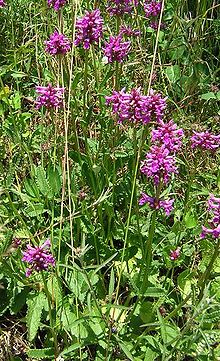Ranilist
Stachys officinalis
Koristi se:
Za zarastanje rana na koži i sluzokoži, otklanja neprijatan zadah
iz usta, protiv groznice, gorušice, bronhitisa, asmatičnog kašlja, upale
desnih. Ulazi u sastav mnogih čajeva.
Upotreba:
Jedna kašika ustinjene biljke, preliti sa 100ml vrele vode, ocediti
posle 30 minuta i piti u gutljajima ne zaslađen.
Dragica Milšević
381 (0) 62 1133208
Stachys officinalis
From Wikipedia, the free encyclopedia
| This article needs additional citations for verification. (June 2013) (Learn how and when to remove this template message) |
| Stachys officinalis | |
|---|---|
 | |
| Scientific classification | |
| Kingdom: | Plantae |
| (unranked): | Angiosperms |
| (unranked): | Eudicots |
| (unranked): | Asterids |
| Order: | Lamiales |
| Family: | Lamiaceae |
| Genus: | Stachys |
| Species: | S. officinalis |
| Binomial name | |
| Stachys officinalis (L.) Trevis. ex Briq. | |
| Synonyms | |
Betonica officinalis L.
| |
Stachys officinalis is commonly known as common hedgenettle,[1] betony, purple betony, wood betony, bishopwort, or bishop's wort. The French common name is betoine, and betoniein German. It is a perennial grassland herb growing to 1 to 2 feet tall.
Pliny (25, 8, 46, § 84) calls the plant both betonica and vettonica, claiming that the Vettones used it as a herbal medicine. The word stachys comes from the Greek, meaning "an ear of grain," and refers to the fact that the inflorescence is often a spike.
Contents
[hide]Description[edit]
Stachys officinalis is a perennial grassland herb growing to 30 to 60 cm (1 to 2 ft) tall. Its leaves are stalked on upright stems, narrowly oval, with a heart-shaped base, with a somewhat wrinkled texture and toothed margins. The calyx is 5–7 mm long, with 5 teeth, edged with bristles. The corolla 1–1.5 cm long. Its upper lip flat, almost straight when seen from the side. Theanthers stick straight out. It flowers in mid summer from July to September, and is found in dry grassland, meadows and open woods in most of Europe, western Asia and North Africa. In theBritish Isles it is common in England and Wales, but rare in Ireland and northern Scotland.
The aerial parts contain phenylethanoid glycosides, (betonyosides A-F) and acetoside, acetoside isomer, campneosides II, forsythoside B and leucosceptoside B.[2] The roots contain diterpene glycosides, betonicosides A-D and the diterpene, betonicolide.[3]
Culture[edit]
Folklore[edit]
The first reference to Betony occurs in a work by the Roman physician Antonius Musa, who claimed it as effective against sorcery. It was planted in churchyards to prevent activity by ghosts.
The Anglo Saxon Herbal recommends its use to prevent bad dreams. ('frightful nocturnal goblins and terrible sights and dreams'). A Welsh charm prescribes:- to prevent dreaming, take the leaves of betony, and hang about your neck, or else drink the juice on going to bed.[4]
Herbal use[edit]
The plant was commonly grown in physic gardens of apothecaries and monasteries for medicinal purposes.
An Italian proverb advises that you should "Sell your coat and buy Betony." While a Spanish compliment states, "He has as many virtues as Betony."
Betony was an ingredient of "Pistoja powder," an old remedy for arthritis and gout.[5] It was also claimed to be effective against snake and dog bites, and was believed to be a cure for drunkenness. Richard E. Banks stated that you should "Eat betony or the powder thereof and you cannot be drunken that day."
John Gerard (1597) said that "It maketh a man to pisse well." While Nicholas Culpeper stated that, "...it preserves the liver and bodies of men from the danger of epidemical diseases, and from witchcraft also" and "...this is a precious herb, well worth keeping in your house." He also states that Betony is astrologically ruled by Jupiter and Aries.
Stachys officinalis (Betonica officinalis) has been used in traditional Austrian medicine internally as tea, or externally as compresses or baths for treatment of disorders of the respiratory tract, gastrointestinal tract, nervous system, skin and gynecological problems.
Modern herbalists prescribe betony to treat anxiety, gallstones, heartburn, high blood pressure, migraine and neuralgia, and to prevent sweating. It can also be used as an ointment for cuts and sores. Not all of these uses are supported by scientific evidence.
Нема коментара:
Постави коментар